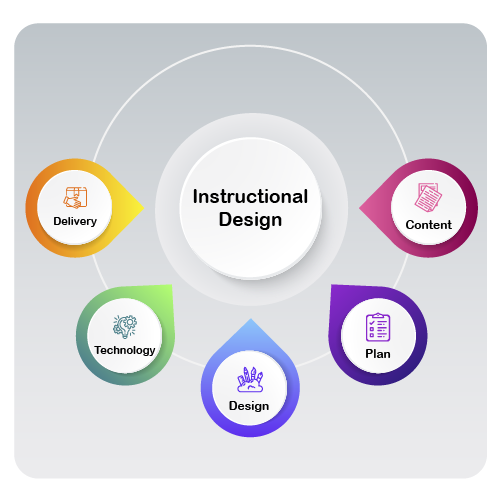There’s an art to learning. And all of us don’t always choose to learn in the same manner. Your way of receiving, comprehending, and storing information might be different from mine. You might prefer to watch an instructional YouTube video and follow along. On the other hand, I might be comfortable with reading the instructions.
We’ve come a long way from trying to subject everyone to a standard learning method. We now realise that everyone learns differently, and hence, all learning and teaching must be ‘inclusive.’ This realisation makes the learning process engaging and more efficient. In simple terms, this is precisely what instructional design is all about.
Decoding Instructional Design
All forms of teaching and learning (read: education) are ‘instructions.’ Instructional design is the systematic development of learning and educational programmes and courses. It ensures that every course or programme is designed while keeping in mind the learners’ needs and preferences. Consequently, the course or programme becomes more effective and helps the learner achieve his/her desired results. If you have created eLearning courses in the past or are planning to create one, instructional design enables you to create an engaging and effective course that meets the learners’ needs. But how does instructional design help you do that?
Let’s discuss some instructional design theories and models that popular universities and online eLearning providers follow while creating their educational programmes and courses.
ADDIE
ADDIE (Analysis, Design, Develop, Implement, Evaluate) was one of the earliest models that helped educators. As the name tells you, this model suggests that we follow five steps while developing an eLearning course.
- Analysis: Why is this course needed? What are the expected results?
- Design: What is the best way to achieve the desired result?
- Develop: How to replicate the design in reality and present it in the best manner?
- Implement: How to deliver the developed product?
- Evaluate: What has been the impact? Did it achieve the desired results?
Merill’s Principals of Instruction (MPI)
In 2002, David Merill proposed a framework that included five learning principles. These principles aimed at helping learners gain maximum knowledge.
- Task-centred principle: Solving a problem or carrying out a task – something that the learner can relate to.
- Activation: Activating the learner’s existing knowledge base – connecting what he knows with what he is currently learning
- Demonstration: Demonstrating knowledge in various mediums – text, images, videos, etc.
- Application: Applying knowledge to see how it works for real-world situations
- Integration: Integrating knowledge into the learner’s context through discussions, reviews, etc.
Gagne’s Nine Events of Instruction
Robert Gagne proposed a framework wherein he followed a behaviourist approach and defined events relevant to different learning situations.
- Gain the attention of learners by engaging them
- Inform them about the expected results and objectives of the course
- Stimulate recall of previously gained knowledge
- Deliver the content in a way that it can be easily consumed
- Guide with examples, case studies, etc.
- Engage them in activities that help them utilise their knowledge
- Provide feedback to reinforce the knowledge
- Assess their performance to some set parameters
- Enhance retention of the information
Bloom’s Taxonomy
Benjamin Bloom proposed to classify and organise various levels of cognitive learning through some measurable verbs:
- Creating
- Evaluating
- Analysing
- Applying
- Understanding
- Remembering
The classification system shows how a learner goes from primary learning (creating and evaluating) to secondary learning (analysing and applying).
There have been many debates on which theory or model works the best; however, each model has its pros and cons. You must decide which model works best for your material, audience, resources, and delivery method.

Instructional Design strategies
So, how can instructional design help you in creating a winning eLearning course? Educators and creators across the world employ these strategies for their courses and recommend them for their effectiveness.
Micro-learning
It is the age of bite-sized information. Instead of reading an entirely new article, many of us would prefer to scroll through some tweets and get the gist of the matter. Why do we do this? Lack of time? Lack of attention? The constant overload of information makes us choose precisely how much time and energy we are willing to spend on a piece of information.
Similarly, bombarding learners with a lot of information within a short time might make them lose interest or forget it quickly. Micro-learning involves breaking down the learning material into small chunks of information that the learners can consume quickly and easily. Whether it’s a video, quiz, infographic, or checklist, the ‘chunk’ should not be of more than 5 to 7 minutes. This quick format and short lessons keep your learners engaged and helps them retain information with some short breaks (as opposed to long breaks).
Personalisation
A great way to keep your learners engaged is to personalise or customise the course for them. You can employ various ways to personalise your course:
- Ask them to enter their first name at the beginning and utilise it for instructions. For instance, “Hi Aarohi. Are you excited to explore the world of investment banking?”
- Ask them to choose an avatar
- Provide options for fonts, background colour, etc.
- Provide options for content medium like quizzes, videos, presentations, audio clips, etc.
Language barrier will be a huge challenge for your international learners. Not being able to access the course in their language usually leads to them quitting, failing to comprehend the material, performing poorly in assessments, and leaving negative feedback for the course. Why not personalise the course for such learners in their native languages? You will be able to reach out to learners of all linguistic preferences and regions.
Authoring tools like Adobe Captivate and Articulate Storyline also have special eLearning localisation features to provide your courses in multiple languages.
Retrieval and Spaced Learning
Say, your course has helped the learners to acquire information. But it’s of no use if they cannot recall it at the right time and use it to solve a problem or add value to the situation. This retrieval of information can be triggered by flashcards, quizzes, multiple-choice questions, etc. Such ‘challenges’ also help you in assessing the progress of the learners.
It helps if the learner is reminded of a piece of information a couple of times. Spaced learning involves providing such ‘recaps’ to learners over a longer time – instead of providing them immediately. Researchers have found that an average learner retains and recalls information better when repeated in a ‘spaced’ manner.


